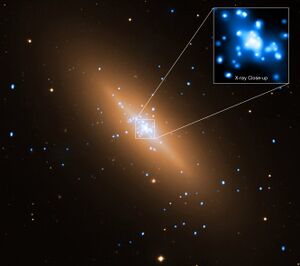Astronomy:NGC 3115
| NGC 3115 | |
|---|---|
 Composite image of NGC 3115 from the Chandra X-ray Observatory and the Very Large Telescope | |
| Observation data (J2000 epoch) | |
| Constellation | Sextans |
| Right ascension | 10h 05m 14.0s[1] |
| Declination | −7° 43′ 07″[1] |
| Redshift | 663 ± 4 km/s[1] |
| Distance | 31.6 ± 1.3 Mly (9.7 ± 0.4 Mpc)[2] |
| Apparent magnitude (V) | 9.9[1] |
| Characteristics | |
| Type | S0−[3] |
| Apparent size (V) | 7.2′ × 2.5′[1] |
| Other designations | |
| Spindle Galaxy, UGCA 199, PGC 29265,[1] Caldwell 53 | |
NGC 3115 (also called the Spindle Galaxy or Caldwell 53) is a field lenticular (S0) galaxy in the constellation Sextans. The galaxy was discovered by William Herschel on February 22, 1787.[4][5] At about 32 million light-years away from Earth, it is several times bigger than the Milky Way. It is a lenticular (S0) galaxy because it contains a disk and a central bulge of stars, but without a detectable spiral pattern. NGC 3115 is seen almost exactly edge-on, but was nevertheless mis-classified as elliptical. There is some speculation that NGC 3115, in its youth, was a quasar.
One supernova has been observed in NGC 3115: SN 1935B (type and mag. unknown).[6][7]
Star formation
NGC 3115 has consumed most of the gas of its youthful accretion disk. It has very little gas and dust left that would trigger new star formation. The vast majority of its component stars are very old.
Black hole
In 1992 John Kormendy of the University of Hawaii and Douglas Richstone of the University of Michigan announced what was observed to be a supermassive black hole in the galaxy.[8] Based on orbital velocities of the stars in its core, the central black hole has mass measured to be approximately one billion solar masses (M☉). The galaxy appears to have mostly old stars and little or no activity. The growth of its black hole has also stopped.
In 2011, NASA's Chandra X-ray Observatory examined the black hole at the center of the large galaxy. A flow of hot gas toward the supermassive black hole has been imaged, making this the first time clear evidence for such a flow has been observed in any black hole. As gas flows toward the black hole, it becomes hotter and brighter. The researchers found the rise in gas temperature begins at about 700 light years from the black hole, giving the location of the Bondi radius. This suggests that the black hole in the center of NGC 3115 has a mass of about two billion M☉, supporting previous results from optical observations. This would make NGC 3115 the nearest billion-solar-mass black hole to Earth.
See also
- NGC 5866 – another lenticular galaxy sometimes referred to as the Spindle Galaxy
References
- ↑ 1.0 1.1 1.2 1.3 1.4 1.5 "NASA/IPAC Extragalactic Database". Results for NGC 3115. http://nedwww.ipac.caltech.edu/.
- ↑ J. L. Tonry; A. Dressler; J. P. Blakeslee; E. A. Ajhar et al. (2001). "The SBF Survey of Galaxy Distances. IV. SBF Magnitudes, Colors, and Distances". Astrophysical Journal 546 (2): 681–693. doi:10.1086/318301. Bibcode: 2001ApJ...546..681T.
- ↑ Tomita, Akihiko; Aoki, Kentaro; Watanabe, Masaru; Takata, Tadafumi; Ichikawa, Shin-Ichi (2000). "The Central Gas Systems of Early-Type Galaxies Traced by Dust Features, Based on the Hubble Space Telescope WFPC2 Archival Images". The Astronomical Journal 120 (1): 123–130. doi:10.1086/301440. Bibcode: 2000AJ....120..123T.
- ↑ O'Meara, Stephen James (2002). The Caldwell Objects. Cambridge: Cambridge University Press. p. 211. ISBN 978-0-521-82796-6.
- ↑ Materne, J. (April 1979). "The structure of nearby groups of galaxies - Quantitative membership probabilities". Astronomy and Astrophysics 74 (2): 235–243. Bibcode: 1979A&A....74..235M.
- ↑ Transient Name Server entry for SN 1935B. Retrieved 28 March 2023.
- ↑ Central Bureau for Astronomical Telegrams list of Supernovae. Retrieved 28 March 2023.
- ↑ Kormendy, J. and Richstone, D. "Evidence for a supermassive black hole in NGC 3115", Astrophysical Journal, Part 1, vol. 393, no. 2, July 10, 1992, p. 559-578.
External links
- Chandra Press Release
- SEDS: NGC 3115
- NGC 3115 on WikiSky: DSS2, SDSS, GALEX, IRAS, Hydrogen α, X-Ray, Astrophoto, Sky Map, Articles and images
Coordinates: ![]() 10h 05m 14.0s, −07° 43′ 07″
10h 05m 14.0s, −07° 43′ 07″
 |

